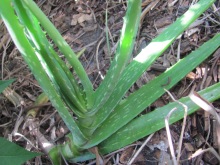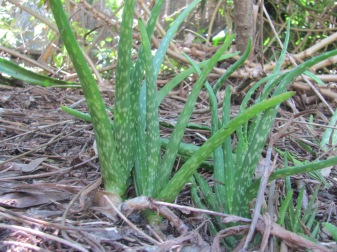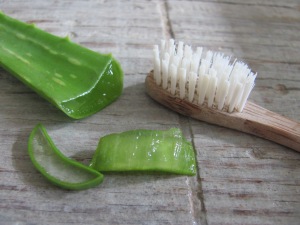Aloe vera (A. barbadensis)
Family: Liliaceae
Common name: Aloe vera
Medicinal:
Anti-bacterial
Anti-inflammatory
Antiseptic
Analgesic
Contraindications:
A small percentage of people are allergic to Aloe; spot test it on your skin first if you have never used it before
Edibility:
Gel from leaves is edible
Avoid eating yellowish gel from leaf base, it is a bitter tasting purgative
Here is an amazing herb which I use everyday, and pulchra plantae is all about encouraging you to use beautiful plants every day, fresh from the plant, with no need to spend money on yet another product!
Aloe has so many practical uses around the home and for your health, I consider it to be one of the essential must-have herbs for the garden. My new favourite way to use Aloe is as a toothpaste. For years I have been searching for an alternative to conventional toothpastes. I have tried a Miswak stick, but that didn’t give me the clean feeling that I wanted (but give it a try, you might like it); I tried a coconut oil based toothpaste recipe, but I didn’t like the texture; I tried purchasing alternative toothpastes, but apart from not being as natural as I would like, I also didn’t like buying them. Enter Aloe. Antibacterial, proven to fight plaque and gingivitis as well as or better than conventional toothpastes, healing, soothing, and FREE! The perfect toothpaste, and you can use it straight from the plant! No need for nasty preservatives! Simply pick a leaf, cut a small section off and rub it (gel side) on your toothbrush. Leave the leaf in the bathroom until it is used up. Then pick another!
If you cut open an Aloe leaf, you will notice that the gel/sap/inner part of the leaf is a clear colour, and the gel at the base of the leaf is yellow in colour. Do not use the yellow part, unless you are looking for a purgative.
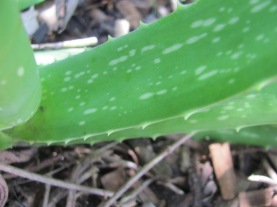
Medicinally Aloe has been used to aid digestion, treat bad breath, asthma, bladder infections, chapped skin, dandruff, dermatitis, herpes, hemorrhoids, mouth ulcers, nausea, acne, stretch marks, burns, stings, itches, fluid retention, cuts, to destroy harmful bacteria and fungi in the intestinal tract, to help produce bowel movements, promote new tissue growth, increase lymphocyte production, and stimulate immune system.
Aloe is great for soothing and healing burns, it penetrates the skin four times faster than water. If you get a burn, liberally cover the burn in Aloe vera gel, then wrap the area in cling wrap. This keeps oxygen out which causes pain and blistering. This method also helps to reduce scarring. Eating gel from the leaf has also been reported to prevent nausea and burning following radium treatment.
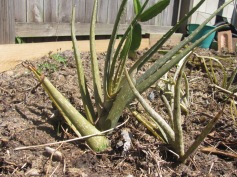
Aloe can be used as an aftershave, and it has quick-healing ,antiseptic properties for shaving cuts. It can be used directly from the plant as an after sun care treatment, replenishing the skin’s moisture, and healing it. It can be used as a hair conditioner by rubbing the gel in all over the head and hair, and leaving it in for several hours, resulting in shiny healthy hair. This also treats dandruff! I have heard say it restores colour to grey hair. If anyone tries this and it works, please let me know!
Aloe drinks can be purchased from the shops, but often contain additives that are not particularly good for you. One alternative is to chop the gel into little cubes and add it to your favourite beverage. I love iced herbal tea, and Aloe makes a great addition.
Isabell Shipard’s amazing herbal mentions many cases of people being cured by Aloe for a range of disorders. One boy was cured of asthma by taking a desertspoon of Aloe and honey three times a day, another baby was cured of reflux, and many women report being cured of thrush.
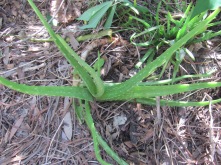
Colour of plant when grown in shade
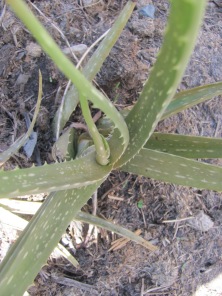
Colour of plant when grown in sun
Aloe is ridiculously easy to grow. Each time I moved I just flung some in a corner of my yard, and forgot to water it and it grew. If I watered it every now and then, it thrived. How much sun it needs depends on your climate, in cold climates tending toward more sun, and hot climates tending more towards shade. If you live in a bog plant it in full sun in a raised bed, a desert give it a shady swale and a reasonable water allowance. Seriously, it’s easy. You can grow it in containers in a sunny window, or even in a non-sunny window. Give it a try. This plant is a miracle.
Notes
Here is a study which actually seems to downplay the findings that Aloe outperforms regular toothpaste, and performs equally as effectively as the ‘control’ toothpaste, by concluding with ‘the use of a toothpaste containing Aloe Vera showed no additional effect on plaque and gingivitis compared to a control toothpaste’.
Here is a study which tested the effectiveness of Aloe tooth gel against two popular commercial brands, and found Aloe to equally effective against all bad bacteria, and performs superiorly against a bacteria which not only causes plaque but also serious heart conditions and other complications.
Here is a naturopathic dentist who promotes Aloe vera for healthy teeth.

